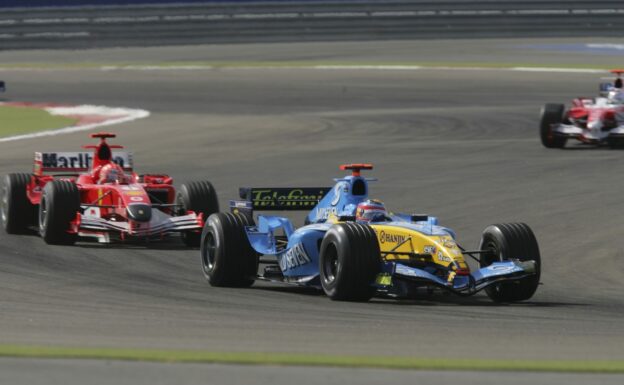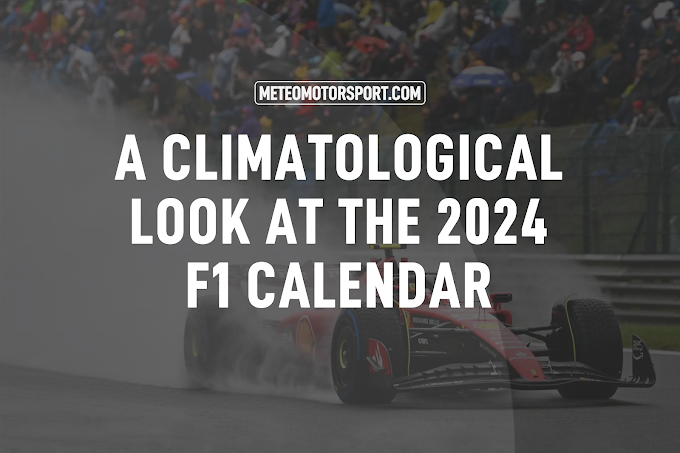MeteoMotorsport has analysed the climatology of each race venue on its scheduled race day to see what conditions are likely at each event in 2022. Further analysis can be found below.
 |
| The climatological temperature range (left) and risk of precipitation (right) for the scheduled race date at the nearest available weather station to each circuit |
Temperature
Hottest: Singapore, Middle East, MiamiWith an average daily temperature of 28°C and a mean daytime maximum of 31°C, Singapore comfortably ranks as climatologically the hottest Grand Prix event on the calendar.
But despite the night-time running, early evening temperatures in Singapore during late September typically reside in the high-20s and thus Singapore remains one of the hottest, if not the hottest, events on the calendar. In fact, the average overnight minimum temperature in Marina Bay in September (26°C) is warmer than the climatological daytime maxima of at least sixteen other venues on the 2022 calendar.
Like Singapore, the three Middle East venues — Bahrain, Saudi Arabia, and Abu Dhabi — also run their events under floodlights in the early evening or night-time.
This avoids the hot desert sunshine and a repeat of the conditions experienced at the 2005 Bahrain Grand Prix — the race was the hottest Formula 1 race on record as air temperatures reached a sweltering 42.5°C and track temperatures peaked at over 55°C. The race surpassed the record temperatures of the 1955 Argentine Grand Prix and the 1984 Dallas Grand Prix.
 |
| 2005 Bahrain Grand Prix: hottest Formula 1 race on record |
Despite avoiding the mid-afternoon sun, these events remain as some of the warmest of the season with temperatures climatologically ranging between 19–23°C in both March (Bahrain and Saudi Arabia) and November (Abu Dhabi).
The Miami Grand Prix joins the calendar in 2022 and is likely to rival Singapore and the Middle East venues to be one of the warmest of the year given its mid-afternoon start time in South Florida in early May — the climatological average daytime high for the 8th of May in the Miami Gardens area is around 29°C. South Florida’s tropical monsoon climate will also make the race prone to the odd tropical thunderstorm (more on precipitation later) and potentially tropical cyclones (stay tuned for a more detailed blog on this next month).
Coolest: Emilia-Romagna and Northwest Europe
From the hottest races, to the coolest. At the other end of the scale, the Emilia-Romagna Grand Prix at Imola is climatologically the coldest on the calendar, with an average daily temperature of just 14°C, owing to its late April springtime calendar slot. Temperatures during the 2021 event, which ran at the same time of year, just about managed to get into double digits; many drivers struggled with cold brakes and tyres.
The Belgian, British, Dutch, and Australian Grand Prix – all known for their changeable weather and cooler days – follow closely behind Imola; they all have daily average temperatures of 16°C or below, and average daily maxima less than 20°C.
Partly due to its altitude, Mexico City provides the largest climatological daily temperature range on the 2022 calendar, with average minimum temperatures of 10°C but daytime average maximum temperatures of 22°C.
Precipitation
Driest: Middle East and AzerbaijanAs one would expect, the Middle East venues are among the climatologically driest on the calendar, with race day precipitation probabilities typically less than 6 percent. Although these venues have yet to host a wet-weather race, it is possible for it to rain in the desert, as the Formula 1 paddock discovered in the days prior to the delayed 2020 Bahrain Grand Prix.
Outside the Middle East, the dry subtropical climate of eastern Azerbaijan means the race on the streets of Baku in early June is also one of the likeliest to remain dry, with just a 4 percent climatological risk of rainfall. Similarly, the southern European venues of Monaco, Catalunya-Barcelona, and Paul Ricard are also likely to remain dry, though showers rolling off the Mediterranean Sea can sometimes pose a risk.
Wettest: Brazil, Austria, Singapore, Canada
Wet weather races are some of the most anticipated thanks to their tendency to produce an entertaining Grand Prix that can sometimes throw up a usual result or winner. There has been at least one rain affected race every year since at least 1994.
For long-time Formula 1 fans, the events most prone to precipitation falling on race day will come as no surprise. Sao Paulo tops the list with a climatological precipitation risk of 46 percent, closely followed by Spielberg (43 percent), Singapore (42 percent), and Montreal (38 percent).
Located in the outskirts of Sau Paulo, the Autódromo José Carlos Pace is a fan favourite and is well-known for its unpredictable and changeable weather. The rain-affected 2008 title decider is certainly one of the circuit’s most memorable races: Lewis Hamilton passed Timo Glock on the last lap to pip race winner Felipe Massa win his first world championship. Other notable wet races include the 2016 Brazilian Grand Prix, which took over 3 hours to complete following multiple accidents that triggered several safety car periods and two red flag stoppages, and the 2003 race, which featured several heavy crashes and was prematurely curtailed on lap 56 of 71.
Nestled in the foothills of the Austrian Alps, the RedBull Ring is also prone to be affected by wet weather. At the 2020 Styrian Grand Prix, the third practice session was cancelled and qualifying was delayed for several hours due to torrential rain. The average risk of precipitation in the circuit's July calendar slot is 43 percent.
Located in the tropics, afternoon convective thunderstorms are a frequent occurrence in Singapore, yet the night-time floodlit race has surprisingly only been affected by adverse weather once – the 2017 race is best remembered for the lap 1 collision between the Ferraris of Sebastien Vettel and Kimi Raikkonen, and RedBull’s Max Verstappen during the run down to turn one:
Lights out under the lights = mayhem under the lights 🙈😮💥#SingaporeGP #F1NightRace #F1 pic.twitter.com/rQ8DCeTjET
— Formula 1 (@F1) September 17, 2017
Montreal probably springs to mind whenever the topic of wet races is mentioned thanks to the well-known 2011 race, which holds the record for the longest ever Formula 1 race duration, at four hours and four minutes, which included a red flag period that lasted over two hours due to torrential rain. Montreal's mid-June calendar slot gives it a climatological risk of precipitation of 38 percent.
The Japanese Grand Prix at Suzuka also ranks as one of the climatologically wettest events on the calendar, with an average rainfall risk of 33 percent. Several races in the last two decades have been affected by torrential rainfall or typhoons (Japan is particularly prone to landfalling tropical cyclones during early October; lookout for a blog on this later in the year).
Climatology But Not A Forecast
This climatological analysis represents the average weather conditions over the last 30 years on the scheduled race date and does not represent a specific forecast for 2022. Real-time weather forecasts are based on an ensemble of numerical weather prediction models, which incorporate observations of air pressure, temperature, humidity, winds, and many other variables to produce the best estimate of current and future conditions in the atmosphere at a range of time horizons.For the latest Formula 1 weather forecast, visit the dedicated MeteoMotorsport F1 Weather Centre, which provides an overview of the current weather conditions, the latest six-day forecast, and real-time satellite and radar imagery of the circuit, and follow MeteoMotorsport on Twitter.
Data Analysis Disclaimer: This analysis uses climatological data of the scheduled race date of the nearest available weather station to each race venue. Note that climatological average daily temperature represents the average of the climatological daily minimum and climatological daily maximum temperatures. While most Grand Prix are likely to take place in the mid-afternoon and therefore coincide with typically the hottest part of the day, this is not always the case, especially for those races that take place at night. The stated climatological risk of precipitation is representative of the risk across the entire 24-hour period of the day (00:00 to 23:59) of the scheduled race date and therefore may not be representative of the approximate two-hour window of the race time.





